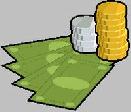
 |
|
| Financial Terms | |
| Total asset turnover |
|
Information about financial, finance, business, accounting, payroll, inventory, investment, money, inventory control, stock trading, financial advisor, tax advisor, credit.
Main Page: accounting, investment, payroll, inventory control, finance, money, stock trading, business, |
Definition of Total asset turnover
Total asset turnoverThe ratio of net sales to total assets.
Related Terms:Total Asset Turnover RatioA measure of the utilization of all of a company's assets to Accounts receivable turnoverThe ratio of net credit sales to average accounts receivable, a measure of how Acquisition of assetsA merger or consolidation in which an acquirer purchases the selling firm's assets. AssetAny possession that has value in an exchange. Asset/equity ratioThe ratio of total assets to stockholder equity. Asset/liability managementAlso called surplus management, the task of managing funds of a financial Asset activity ratiosRatios that measure how effectively the firm is managing its assets.  Asset allocation decisionThe decision regarding how an institution's funds should be distributed among the Asset-backed securityA security that is collateralized by loans, leases, receivables, or installment contracts Asset-based financingMethods of financing in which lenders and equity investors look principally to the Asset classesCategories of assets, such as stocks, bonds, real estate and foreign securities. Asset-coverage testA bond indenture restriction that permits additional borrowing on if the ratio of assets to Asset for asset swapCreditors exchange the debt of one defaulting borrower for the debt of another Asset pricing modelA model for determining the required rate of return on an asset. Asset substitutionA firm's investing in assets that are riskier than those that the debtholders expected. Asset substitution problemArises when the stockholders substitute riskier assets for the firm's existing  Asset swapAn interest rate swap used to alter the cash flow characteristics of an institution's assets so as to Asset turnoverThe ratio of net sales to total assets. Asset pricing modelA model, such as the Capital asset Pricing Model (CAPM), that determines the required AssetsA firm's productive resources. Assets requirementsA common element of a financial plan that describes projected capital spending and the Capital asset pricing model (CAPM)An economic theory that describes the relationship between risk and Current assetsValue of cash, accounts receivable, inventories, marketable securities and other assets that Dynamic asset allocationAn asset allocation strategy in which the asset mix is mechanistically shifted in Exchange of assetsAcquisition of another company by purchase of its assets in exchange for cash or stock. Financial assetsClaims on real assets. Fixed assetLong-lived property owned by a firm that is used by a firm in the production of its income. Fixed asset turnover ratioThe ratio of sales to fixed assets. Intangible assetA legal claim to some future benefit, typically a claim to future cash. Goodwill, intellectual Inventory turnoverThe ratio of annual sales to average inventory which measures the speed that inventory Liquid assetasset that is easily and cheaply turned into cash - notably cash itself and short-term securities. Long-term assetsValue of property, equipment and other capital assets minus the depreciation. This is an Limitation on asset dispositionsA bond covenant that restricts in some way a firm's ability to sell major assets. Net asset value (NAV)The value of a fund's investments. For a mutual fund, the net asset value per share Net assetsThe difference between total assets on the one hand and current liabilities and noncapitalized longterm Non-reproducible assetsA tangible asset with unique physical properties, like a parcel of land, a mine, or a Other current assetsValue of non-cash assets, including prepaid expenses and accounts receivable, due Policy asset allocationA long-term asset allocation method, in which the investor seeks to assess an Portfolio turnover rateFor an investment company, an annualized rate found by dividing the lesser of Publicly traded assetsassets that can be traded in a public market, such as the stock market. Quick assetsCurrent assets minus inventories. Real assetsIdentifiable assets, such as buildings, equipment, patents, and trademarks, as distinguished from a Receivables turnover ratiototal operating revenues divided by average receivables. Used to measure how Reproducible assetsA tangible asset with physical properties that can be reproduced, such as a building or Residual assetsassets that remain after sufficient assets are dedicated to meet all senior debtholder's claims in full. Return on assets (ROA)Indicator of profitability. Determined by dividing net income for the past 12 months Return on total assetsThe ratio of earnings available to common stockholders to total assets. Riskless or risk-free assetAn asset whose future return is known today with certainty. The risk free asset is Risky assetAn asset whose future return is uncertain. Risk-free assetAn asset whose future return is known today with certainty. Tactical Asset Allocation (TAA)An asset allocation strategy that allows active departures from the normal Tangible assetAn asset whose value depends on particular physical properties. These i nclude reproducible Total debt to equity ratioA capitalization ratio comparing current liabilities plus long-term debt to Total dollar returnThe dollar return on a nondollar investment, which includes the sum of any Total returnIn performance measurement, the actual rate of return realized over some evaluation period. In Total revenuetotal sales and other revenue for the period shown. Known as "turnover" in the UK. TurnoverMutual Funds: A measure of trading activity during the previous year, expressed as a percentage of Underlying assetThe asset that an option gives the option holder the right to buy or to sell. Wasting assetAn asset which has a limited life and thus, decreases in value (depreciates) over time. Also ASSETSAnything of value that a company owns. Current assetsCash, things that will be converted into cash within a year (such as accounts receivable), and inventory. INVENTORY TURNOVERThe number of times a company sold out and replaced its average stock of goods in a year. The formula is: RATE OF RETURN ON TOTAL ASSETSThe percentage return or profit that management made on each dollar of assets. The formula is: AssetsThings that the business owns. Current assetsAmounts receivable by the business within a period of 12 months, including bank, debtors, inventory and prepayments. Fixed assetsThings that the business owns and are part of the business infrastructure – fixed assets may be Intangible fixed assetsNon-physical assets, e.g. customer goodwill or intellectual property (patents and trademarks). Tangible fixed assetsPhysical assets that can be seen and touched, e.g. buildings, machinery, vehicles, computers etc. TurnoverThe business income or sales of goods and services. AssetsItems owned by the company or expenses that have been paid for but have not been used up. Contra-asset accountAn offset to an asset account that reduces the balance of the asset account. Intangible assetsassets owned by the company that do not possess physical substance; they usually take the form of rights and privileges such as patents, copyrights, and franchises. accounts receivable turnover ratioA ratio computed by dividing annual asset turnover ratioA broad-gauge ratio computed by dividing annual current assetsCurrent refers to cash and those assets that will be turned fixed assetsAn informal term that refers to the variety of long-term operating inventory turnover ratioThe cost-of-goods-sold expense for a given return on assets (ROA)Although there is no single uniform practice for Asset-specific RiskThe amount of total risk that can be eliminated by diversification by Capital Asset Pricing Model (CAPM)A model for estimating equilibrium rates of return and values of Fixed Assets Turnover RatioA measure of the utilization of a company's fixed assets to Inventory Turnover RatioProvides a measure of how often a company's inventory is sold or Return on Total Assets RatioA measure of the percentage return earned on the value of the Total Debt to Total Assets RatioSee debt ratio asset turnovera ratio measuring asset productivity and showing the number of sales dollars generated by each dollar of assets capital assetan asset used to generate revenues or cost savings total contribution marginsee contribution margin total cost to account forthe sum of the costs in beginning total expected value (for a project)the sum of the individual cash flows in a probability distribution multiplied by their related probabilities total overhead variancethe difference between total actual overhead and total applied overhead; it is the amount of underapplied or overapplied overhead total quality management (TQM)a structural system for creating organization-wide participation in planning and implementing a continuous improvement process that exceeds total units to account forthe sum of the beginning inventory total variancethe difference between total actual cost incurred AssetA resource, recorded through a transaction, that is expected to yield a benefit to a Capital assetA fixed asset, something that is expected to have long-term usage within Current assetTypically the cash, accounts receivable, and inventory accounts on the Fixed assetAn item with a longevity greater than one year, and which exceeds a company’s Intangible assetA nonphysical asset with a life greater than one year. Examples are Other assetsA cluster of accounts that are listed after fixed assets on the balance sheet, Related to : financial, finance, business, accounting, payroll, inventory, investment, money, inventory control, stock trading, financial advisor, tax advisor, credit. |